 |
 |
|
 |
Torrential downpours flood southern Minnesota, closing several highways |
 |
 |
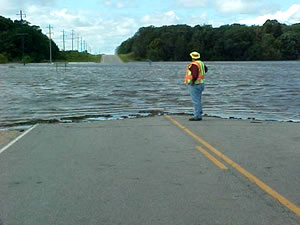 |
Larry Kruckeberg, District 6 West sign supervisor, checks out the 'lake' on Hwy 251 near Maple Island after torrential downpours and overflowing rivers and streams put nine feet of water over the road. Photo by Tom Johnson |
The phrase 'spring flooding' is pretty common to people in southeastern Minnesota. Ten or 12-inch winter snowstorms are not unusual either. But floods in September caused by 10- to 12-inch rainstorms? Now, that's another story.
This story opened with torrential downpours that began early evening on Sept. 14, and didn't let up until daybreak on Sept. 15. By then, several counties in southeastern Minnesota were soaking in the floods’ aftermath.
The rain and resulting flash flooding closed several segments of Interstate 90 in Austin and east of Austin; Hwy 63 in Spring Valley; Hwy 65 in Albert Lea; Hwy 30 west of Ellendale; Hwy 56 between Le Roy and Rose Creek; Hwy 105 south of Austin; and Hwy 251 between Maple Island and Hollandale.
In District 7, flooding closed a segment of I-90 near Alden and Hwy 22 west of Alden.
"We're used to spring flooding closing several state highways in our area, but this is the first time I can remember closing roads because of floods in September," said Roger Cummings, Austin maintenance supervisor, who added that the depth of the flood waters in Austin broke an unofficial record that has stood since 1983.
"Back then, floodwaters went six feet high on the wall of our old shop. The new mark is seven-and-a-half feet," Cummings said.
 |
Troy Danielson, District 6 Design, paddles down his 'driveway' on Sept. 16 with his wife and son so they can get to work and school. Photo courtesy of Troy Danielson |
While Mn/DOT crews in Mower, Freeborn, Steele, Dodge and Fillmore counties were staying busy barricading roads and moving sand, Troy Danielson, District 6 Design, woke up Sept. 16 with another problem—a small lake had formed over his driveway. Danielson said the level of the South Branch of the Root River near his home in Pilot Mound appeared okay Wednesday night, but by early Thursday morning the river had jumped six feet above flood stage.
"In a flood, the strong currents move out of the banks and away from the road so when I drove to check it at 5 a.m. Thursday, what was a bean field and a gravel township road appeared to be a very calm lake. It completely covered the fields and the township road," Danielson explained. To get his son to school and his wife to work, Danielson had to paddle a boat from his house to the main road where they met a school bus and a coworker going the same way.
The water receded quickly, and by 4 p.m. Thursday, he was able to drive out to meet his son getting off the bus.
Though most of the rain stopped falling by daybreak Wednesday morning, the effects of all the water would be felt for days to come. On Wednesday morning, I-90 was closed between Hwy 56 (Brownsdale) and Hwy 16 (Dexter). The roadway reopened by mid-morning, but then closed in Austin overnight as floodwaters overflowed onto the roadway.
And in Freeborn County, flood waters were still covering portions of Hwy 251 near Hollandale and Hwy 65 in Albert Lea several days after the storm.
Damage estimates from the storm will probably exceed $20 million, with the city of Austin being one of the hardest hit. The Red Cross indicated that flooding damaged more than 3,000 southeastern Minnesota homes.
Throughout the event, District 6 maintenance, bridge and sign shop crews once again responded with the tools and skills to make sure a bad situation didn't get worse. There are more than a few homeowners, businesses and motorists who are grateful they did.
By Brian Jergenson, District 6 public affairs coordinator
|
back

|
 |
Travel time system tested in Metro area |
 |
 |
Mn/DOT’s Regional Transportation Management Center began testing a new system Sept. 21 that displays travel times on freeway changeable message signs in the northbound lanes of Hwy 77 in Apple Valley.
This new service provides drivers with the travel time in minutes from the sign location to a significant point on the road ahead, in this case, to the Minnesota River and to westbound Hwy 62 (Crosstown). The service runs during the morning rush hours (6 a.m. to 9 a.m.), Monday through Friday.
“It gives the traveling public the chance to make a choice about their route of travel,” said Nick Thompson, manager of operations at RTMC. “If the road ahead is very congested, then a driver can decide to take a different route that might not be as busy.”
The system uses traffic detection devices, known as loop detectors, which are installed throughout the Twin Cities Metro highway system. The loop detectors keep track of how many cars are on the roadway and how quickly they are moving.
The travel time system bases the displayed time on the posted speed limit. The computerized system takes readings from the loop detectors along designated routes and updates the time every 30 seconds.
Other information regarding road conditions—such as crashes, stalls or other problems—will pre-empt the travel time message until the condition clears, Thompson said.
Click here to read the rest of the news release. This link will also direct you to other recent news releases posted on Mn/DOT’s Web site.
By Kevin Gutknecht
|
back

|
 |
State drives toward improved government services |
 |
 |
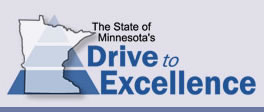 |
|
The Drive to Excellence plan will encompass 72 agencies, commissions and boards in the executive branch in search of ways to improving delivery of government services. |
Over the next four months, the state will analyze all business functions and information technology resources to identify opportunities for improving government services, under the “Drive to Excellence” plan the governor announced Sept. 9.
"Our goal is to move from the current practice in state government of each department being largely autonomous to a more enterprise or 'whole state' approach to running the business of government," Gov. Tim Pawlenty said in a letter to all state employees. "This initiative will result in a more coordinated, governmentwide approach to things such as information technology, human resources, accounting, training and safety."
The study is scheduled for completion by January 2005, and will encompass 72 agencies, commissions and boards in the executive branch. The results will be a set of projects and recommendations to influence preparation of the governor's 2006-07 budget.
Leading Mn/DOT’s efforts towards this goal are Mike Barnes, Information Technology, who is the agency lead; Jeanne Almquist, Business & Support Services, and Janet Blacik, Technical Support, who are subject area experts, and Tom Glancy, Information Technology, who is the technology specialist. This team will work with other Mn/DOT staff as needed to collect information on current business functions and technology assets.
“Drive to Excellence is about improving our service delivery, not just cutting costs,” Barnes said. “This could mean, for example, providing more Mn/DOT services electronically from start to finish.”
Deloitte Consulting LLP, a firm that has conducted similar business analyses with other state governments and major corporations, will assist with the administration’s statewide effort.
More information about the Drive to Excellence effort is available at http://www.excellence.state.mn.us. Click here to read the governor’s Sept. 9 news release.
|
back

|
 |
Mn/DOT officials visit Russia to share knowledge, sign partnership agreement |
 |
 |
Mn/DOT officials visited the Marii El Republic of Russia to share the state’s experiences with building roads and developing a safe and efficient transportation network system.
Upon the completion of the visit, Lt. Gov./Commissioner Carol Molnau and the Marii El vice president signed a Memorandum of Understanding, an agreement outlining each group’s roles in the partnership.
“We were happy to be able to assess the needs of the area we visited, especially in light of the Federal Highway Administration’s direction to share information to help make transportation safe around the world,” said Molnau. “It is also an opportunity for Minnesota businesses to help supply the technology needed for improved safety and it helps open the door to them as well.”
Operation, Safety and Technology Division Director Marthand Nookala and State Construction Engineer Gary Thompson, along with a FHWA representative, accompanied Molnau on the trip to provide their expertise.
“It was a privilege to be able to work with the officials of Marii El and share our knowledge of constructing roads,” said Nookala. “We have gained another partner in the transportation field, and we hope to provide the advice Marii El needs to have a safe, well-designed system.”
During the nine-day trip, the group visited several construction sites, a bituminous plant and a concrete plant. They also delivered presentations about Minnesota, the Mn/DOT organization, funding issues, new technologies and innovative contracting to an industry forum and engineers at the local university. Molnau also served as a keynote speaker at an industry ceremony celebrating 75 years of official road building.
Among those present were Marii El’s administrators and contractors who attended the presentations to gain a better understanding of their roles and the importance of communication between the two groups when working on a project.
“The highway administrators, contractors and the university have the knowledge and, better yet, the burning desire to build good quality roads,” said Thompson, Office of Construction and Innovative Contracting director. “It was rewarding to provide them with some additional guidance and information that they can apply to their transportation system.”
“The president of Marii El recognizes the importance of a good highway system and has made the highway infrastructure a top priority,” Molnau said. “I’m proud that Mn/DOT can be a model state and contribute our knowledge toward their efforts.”
FHWA sponsored the trip as part of its Twinning Program, which focuses on partnerships and relationship-building among federal, state and local government with international counterparts specifically for highway-related topics.
By Daneeka Marshall-Oquendo
|
back

|
 |
Safety advocates propose comprehensive plan to stem epidemic of traffic crash-related deaths |
 |
 |
 |
Bernie Arseneau, Mn/DOT’s director of Traffic, Security and Operations, urged participants at the Toward Zero Deaths Conference in St. Cloud to keep sharing their commitment to increasing safety and reducing traffic fatalities. |
A broad spectrum of safety advocates called for treating Minnesota’s growing number of traffic deaths broadly as a public health issue rather than treating specific causes after crashes have already occurred. The change in approach was announced during the Toward Zero Deaths Conference held Sept. 13-14 in St. Cloud.
Conference leaders said factors causing traffic deaths and injuries need to be addressed similarly to AIDS, cancer, suicide and other major health issues.
“Six hundred fifty-five fatalities in Minnesota in 2003 is a long way from zero, but if we work together, learn from each other and take a proactive instead of reactive approach, we could easily cut the fatality rate by 15 percent within a few years,” said Michael Campion, Department of Public Safety commissioner.
In order to reach the zero deaths goal, Campion said Public Safety, other government agencies, health care providers and community-based groups must share their resources, expertise and energy.
Campion also called for adding two more “Es” to the more familiar three “Es” of traffic safety—engineering, education and enforcement. To reach zero deaths, he proposed adding an “E” for emergency responders, emergency room doctors and nurses and others who need additional training and support to care for crash victims. He also proposed an “E” to represent “everyone else.”
Motorists can take major steps toward the zero deaths goal by slowing down, buckling up, driving sober and paying attention, he said.
Campion’s call for a broad, preventive approach to traffic safety was echoed by other conference leaders.
Beth Alicandri, director of the FHWA’s Office of Safety Programs, said the toward zero deaths effort dovetails well with the federal agency’s goal to reduce traffic deaths in the United States from 1.5 per 100 million miles traveled to one percent by 2008. The one-half percent drop, she said, would save about 9,000 lives each year. In 2003, she said, the United States experienced 6.3 million crashes and 42,643 fatalities. During the same year, Minnesota recorded traffic 655 fatalities.
“Increased use of safety belts, infrastructure improvements and better driver behavior will enable us to reach this goal,” she said.
Alicandri noted that the World Health Organization has declared traffic deaths a worldwide epidemic. She also said since 1972 the United States has dropped from fifth to eighth place in international traffic safety rankings.
“Others are doing better; we can, too,” she said.
To gather expertise to reduce the state’s traffic crash fatality rate, conference participants attended workshop sessions on topics such as the proper use of child passenger safety seats, insights into driver behavior and ways local governments can solve traffic safety problems.
The workshop on local governments examined several ways to reduce the number and severity of traffic crashes. They include using automated cameras for red light and speeding enforcement, lower speed zones in areas with high pedestrian use and reducing the complexity of intersections. Workshop participants also reviewed safety audits, the practice of quantifying the cost of solving a problem, such as a missing traffic sign or adding a right turn lane, and comparing it with the cost savings that would result.
Conference participants also discussed including representatives from the judiciary and auto insurance providers in the Toward Zero Deaths effort to gain their perspective and experience about the impact of auto crash cases on the judicial system and their cost to policy holders and the public in general.
Marsha Lembke, a traffic safety official with the North Dakota DOT, said the conference energized her and other participants to keep the momentum going and to seek new ways to improve traffic safety.
North Dakota, she said, has already involved its judicial branch in efforts such as improving drivers’ skills and considers reducing traffic deaths its first health care priority.
Dick Larson, Mille Lacs County engineer, said communities such as Princeton and Cambridge have ongoing TZD programs and that the county has involved the sheriff’s department as an advocate for the safety of child passengers.
He added that the use of safety audits and communities’ showing a can-do attitude can embed the need for greater public safety in county residents’ minds.
Kathy Burke Moore, deputy director of traffic safety with DPS, said conference participants from different agencies interacted well in general and workshops sessions, adding to the excitement and worth of the conference. More than 450 people attended the conference, she said.
Addressing the conference at its beginning and end, Bernie Arseneau, Mn/DOT’s director of Traffic, Security and Operations, urged participants to keep sharing their expertise and commitment to increasing safety and reducing traffic fatalities.
“You all bring a different set of perspectives to our TZD effort,” he said. “Please keep your energy up to keep us moving toward our goal.”
By Craig Wilkins
|
back

|
 |
Department expands its Affirmative Action services |
 |
 |
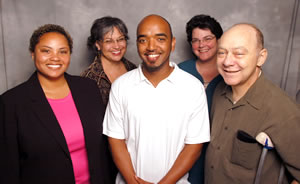 |
|
From left are the members of the expanded Affirmative Action Office: Kim Collins, affirmative action case manager; Lynnette Geschwind, affirmative action officer; Simon Wolde, transportation program specialist; Rosemarie Merrigan, conflict resolution specialist, and Bruce Lattu, disabilities program coordinator. Photo by David Gonzalez |
The Affirmative Action Office has expanded its services to improve the department’s Affirmative Action program.
“We’re going to provide more resources, tools, training and consulting to help managers and supervisors achieve a respectful workplace for all employees,” said Lynnette Geschwind, affirmative action officer.
Mn/DOT is also providing these additional services to ensure the department’s compliance with the federal and state law with regards to fair processes.
“The department has always had Affirmative Action policies and procedures in place, but we want to take steps that will create a greater service network and increased awareness of what the policies and procedures entail. We want to be available with standardized services statewide,” Geschwind said.
To manage the extended responsibilities of the program, Mn/DOT hired four new Affirmative Action staff members to help meet departmental needs:
- Bruce Lattu serves as the disabilities program coordinator focusing on compliance of the Americans with Disabilities Act and the Family Medical Leave Act. He also plays a lead role in the investigative process.
- Kim Collins serves as the Affirmative Action case manager in charge of the development of a departmentwide case management process that will include a tracking system. She also will conduct investigations of discrimination complaints.
- Rosemarie Merrigan joins the office as the conflict resolution specialist focusing on mediation and resolution of discrimination issues. She also will develop and implement early resolution strategies to expedite complaint resolution.
- Simon Wolde serves as the transportation program specialist responsible for developing the department’s Affirmative Action plan that’s required by the state, and he will also produce the annual affirmative action report required by the Federal Highway Administration.
“Hiring the extra staff demonstrates the department’s commitment to improving the Affirmative Action program,” said Geschwind. “We can now dedicate the time and resources necessary to provide consistent assistance in all matters related to compliance.”
Affirmative Action staff members will move to the 5th floor of the Transportation Building in St. Paul within the next month to provide a more private environment for all employees who want to use their services. For more information about the program, contact Geschwind at 651/296-1016.
By Daneeka Marshall-Oquendo
|
back

|
 |
Transport vehicle makes quick work of moving safety barriers to manage traffic flow, protect workers |
 |
 |
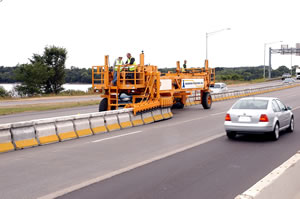 |
|
The barrier transport vehicle, aka "the zipper," makes it possible to quickly shift the flow of traffic while keeping highway workers protected. It takes only about 15 minutes to move a half-mile of barriers. Photo by David Gonzalez |
It looks like a giant, orange praying mantis as it gobbles up concrete traffic barriers, moves them across its abdomen and then deposits them in an adjacent lane.
The machine, known as the barrier transport vehicle, makes it possible to quickly shift the flow of traffic while keeping highway workers protected. It takes only about 15 minutes for it to move a half-mile of barriers.
The vehicle hooks the barriers with a special coupling, moves them to the opposite side on steel rollers, then drops them where needed.
The system is often referred to as the “zipper” because it pulls two lines of barriers together in the same way a zipper operates on clothing.
Mn/DOT officials viewed its operation on Interstate 94 bridge at Hudson, Wis. where the Wisconsin DOT is using the moveable barrier system for the first time. The area involved is the Hudson bridge, which extends from Hwy 95 in Minnesota to Wisconsin Hwy 35 just across the St. Croix River.
Mike Engh, a work zone supervisor with Metro’s Office of Traffic, said the zipper system has worked well since Wis/DOT started using it this spring. The individual barriers are concrete but, at one meter (about 39 inches) in length, are shorter than the standard Jersey barriers.
The barriers also feature an improved interlock system that helps machine operators place them along the freeway. The interlock system also helps ensure the barriers stay in place until they are moved again.
Engh said because traffic on the freeway is so heavy, the crews set the barriers in the morning so that three of the available five lanes handle commuters headed westbound toward the Twin Cities metro area. The two other lanes carry eastbound traffic into Wisconsin. In the afternoon, the barriers are moved to provide three lanes for eastbound travelers and the remaining two lanes for motorists heading west.
The barrier system improves traffic flow in the area where Wis/DOT is re-decking the bridge over the St. Croix River. The agency is also moving the bike and pedestrian lane from the westbound direction to eastbound so it will connect more directly with bike and pedestrian paths on each side of the bridge. And the barriers provide effective protection for crews working in a restricted area very close to heavy traffic.
Bob Anderson, the Wis/DOT project manager, said the system enables keeping at least three lanes open for the morning and evening traffic peaks and provides good protection for workers on the project.
The barriers, though smaller than the standard Jersey barriers, provide the same level of protection when struck by a vehicle as the larger barriers he said.
Anderson said having to provide the lanes to handle the bridge’s 70,000 average daily traffic count and limited space available for crews make the system an appropriate fit for the situation.
Anderson and Casandra Isaackson, Metro’s traffic control engineer, said both DOTs are considering future applications of the system. The system wouldn’t work for every situation, they said, but it provides an option for roadwork involving morning and evening traffic peaks and limited right of way in which crews can work safely and effectively.
Isaacson said Mn/DOT will consider using the zipper system where it’s the most appropriate tool to use.
Anderson said based on its experience, Wis/DOT is looking to use it again.
“It provides great protection,” he said, “and helps us manage traffic when we have commuting peaks in different directions and need to avoid back-ups, gridlock and other traffic-related problems.”
By Craig Wilkins
|
back

|
 |
Barron appointed new project manager for Hiawatha LRT |
 |
 |
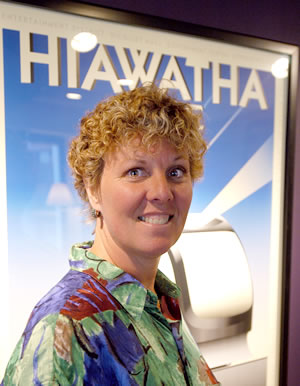 |
Vicki L. Barron, principal engineer, is the new design build project manager of Hiawatha Light Rail Transit project. Photo by David Gonzalez |
Vicki L. Barron, principal engineer, is the new design build project manager of Hiawatha Light Rail Transit, Pat Hughes, Metro District engineer announced Aug. 26. She replaces Jack Caroon, who retired recently. Her appointment was effective Aug. 30.
A 22-year Mn/DOT employee, Barron has worked as a project engineer on a variety of highway construction projects, including the I-94/I-35E Capitol interchange project. She joined the LRT team in 1999 as the utility coordination manager and construction compliance manager. Barron became the deputy design build project manager in 2002.
“Vicki’s leadership skills and experience will provide a consistent level of service,” Hughes said.
The Hiawatha project is 95 percent complete and on schedule for opening to the airport and the Mall of America by the end of the year.
“I’m thrilled to be a part of something that will have a significant impact on the lives of Minnesota citizens,” she said.
Follow this link for more information about the Hiawatha LRT project: http://www.dot.state.mn.us/metro/lrt/.
By Lisa Yang
|
back

|
 |
Walz takes mobility assignment with House of Representatives |
 |
 |
Cathy Walz, director of Workforce Development, is now serving as the managing director of the Administrative Services Department with the Minnesota House of Representatives. Her mobility assignment with the House was effective Sept. 16 and will last from six to 12 months.
In this role, Walz will provide support and expertise to the legislative body’s nonpartisan administrative support function.
Eric Davis, workforce development programs supervisor, will serve as the office’s acting director during Walz’s mobility.
This mobility opportunity is consistent with Mn/DOT’s effort to support its managers in gaining new expertise and widening their management perspective, said Kevin Gray, Finance and Administration Division director.
Since joining Mn/DOT in 1997, Walz has served in various professional and leadership roles within the offices of Work Force Development, Human Resources and Quality. Previously, she worked in the departments of Employee Relations and Economic Security.
She holds a bachelor’s degree in public relations from the College of St. Benedict and a master’s degree in education from St. Cloud State University.
Walz’s office is in Room 198 of the State Office Building.
|
back

|
 |
Steger leaves FHWA Minnesota division office |
 |
 |
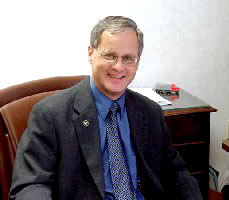 |
|
Alan Steger, who served for more than nine years as Minnesota division administrator for the Federal Highway Administration, is assuming greater responsibilities as FHWA director of Field Services East, which includes Minnesota. |
Alan Steger, who served for more than nine years as Minnesota division administrator for the Federal Highway Administration, is moving on while maintaining his connection to Minnesota transportation interests. He is assuming greater responsibilities as FHWA director of Field Services East. This division serves 31 Eastern States and includes Minnesota as well as Puerto Rico and the Virgin Islands.
Steger will be based in Baltimore, Md. He is replaced by Robin Schroeder, acting Minnesota division administrator.
According to Al Schenkelberg, Investment Management director, Minnesota currently receives in excess of $400 million per year in FHWA program funds. He said the funds are comprised of formula funds apportioned to the states by legislative formulas and other federal funds that are allocated to the states either at the discretion of the FHWA or by direct Congressional earmarking.
‘’Mn/DOT is the primary recipient of nearly all Federal-aid highway funds in Minnesota although some of the funding is passed through the department for local city and county projects and metropolitan planning organizations,” said Schenkelberg. “The funds are available for multiple purposes, including highway design, right of way, construction, planning, research and transit capital projects.
“We continue to enjoy a strong partnership with the local FHWA office,” Schenkelberg added. “Al has always been a strong leader in transportation and he willl be missed.”
The FHWA is a major agency of the U.S. Department of Transportation, a cabinet-level organization of the executive branch of the U.S. government. For more information about the FHWA, visit the Web site at http://www.fhwa.dot.gov/mndiv/index.htm. Information on all DOT agencies can be found at http://www.dot.gov/DOTagencies.htm.
By Jeanne Aamodt
|
back

|
 |
Civil engineering program receives accreditation |
 |
 |
Minnesota State University-Mankato’s civil engineering program, begun in fall 2000, has received accreditation from the Accreditation Board for Engineering and Technology, Inc., the nationally recognized accreditor for college and university programs in applied science, computing, engineering and technology.
The accreditation is retroactive to October 2002. It’s the first time in 68 years that a new civil engineering program has been accredited in Minnesota.
A degree from an ABET-accredited school is important for any civil engineer who wants to be become a registered professional engineer (certified to approve plans for public and private buildings, streets and roads and other projects).
Find out more about the program at http://cset.mnsu.edu/mece/ce/.
|
back

|
 |
|
 |



